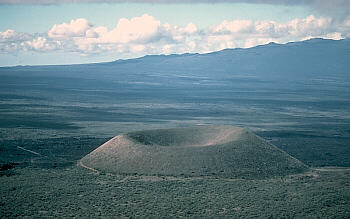cinder cone

This cinder cone (Pu`u ka Pele) was erupted low on the southeast flank of Mauna Kea Volcano. The cone is 95 meters in height, and the diameter of the crater at the top is 400 meters. Hualalai Volcano in background. Credit: J. P. Lockwood / US Geological Survey.
A cinder cone is a steep, conical hill of volcanic fragments that accumulate around and downwind from a vent. The rock fragments, often called cinders or scoria, are glassy and contain numerous gas bubbles "frozen" into place as magma exploded into the air and then cooled quickly. Cinder cones range in size from tens to hundreds of meters tall. The coarser the ejected material, the steeper the sides of the cone.
Cinder cones usually erupt lava flows, either through a breach on one side of the crater or from a vent located on a flank. Lava rarely issues from the top (except as a fountain) because the loose, non-cemented cinders are too weak to support the pressure exerted by molten rock as it rises toward the surface through the central vent.
Perhaps the most famous cinder cone, Paricutin, grew out of a corn field in Mexico in 1943 from a new vent. Eruptions continued for 9 years, built the cone to a height of 424 meters, and produced lava flows that covered 25 square kilometers.
Cinder cones are commonly found on the flanks of shield volcanoes, stratovolcanoes, and calderas. For example, geologists have identified nearly 100 cinder cones on the flanks of Mauna Kea, a shield volcano located on the island of Hawaii (these cones are also referred to as scoria cones and cinder and spatter cones).
Earth's most historically active cinder cone is Cerro Negro in Nicaragua. It is part of a group of four young cinder cones northwest of Las Pilas volcano. Since it was born in 1850, it has erupted more than 20 times, most recently in 1992 and 1995.


